These drumsticks and thighs are coated in a bold, smoky dry rub, then grilled to perfection over gas or charcoal for that irresistible charred edge. Whether you're cooking for a weeknight dinner or weekend cookout, this recipe delivers tender, finger-lickin' good chicken every time.
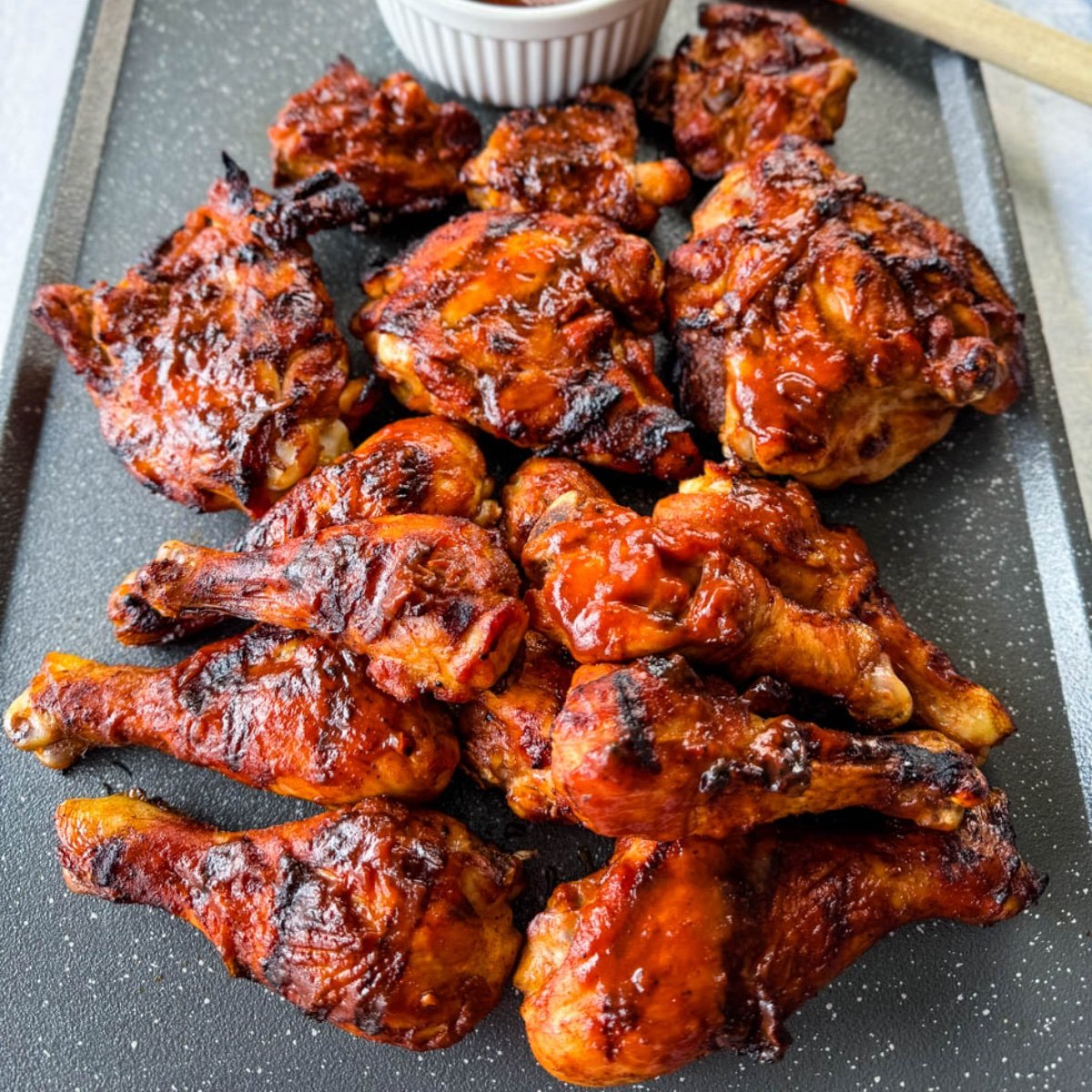
Want to save this recipe for later?
If you want to make chicken wings, too you will love my recipe for How to Grill Chicken Wings on Gas or Charcoal grill and be sure to pair your grilled chicken with classic sides like Creamy Southern Coleslaw,
Vinegar Based Coleslaw with No Mayo, Soul Food Potato Salad, and Southern Baked Beans with Bacon.
Table of Contents
Key Ingredients
- Chicken Thighs and Drumsticks
- Soy Sauce
- Brown Sugar or Sweetener
- BBQ Sauce
- BBQ Rub, Chicken Rub, or these spices: chili powder, smoked paprika, garlic powder, and onion powder.
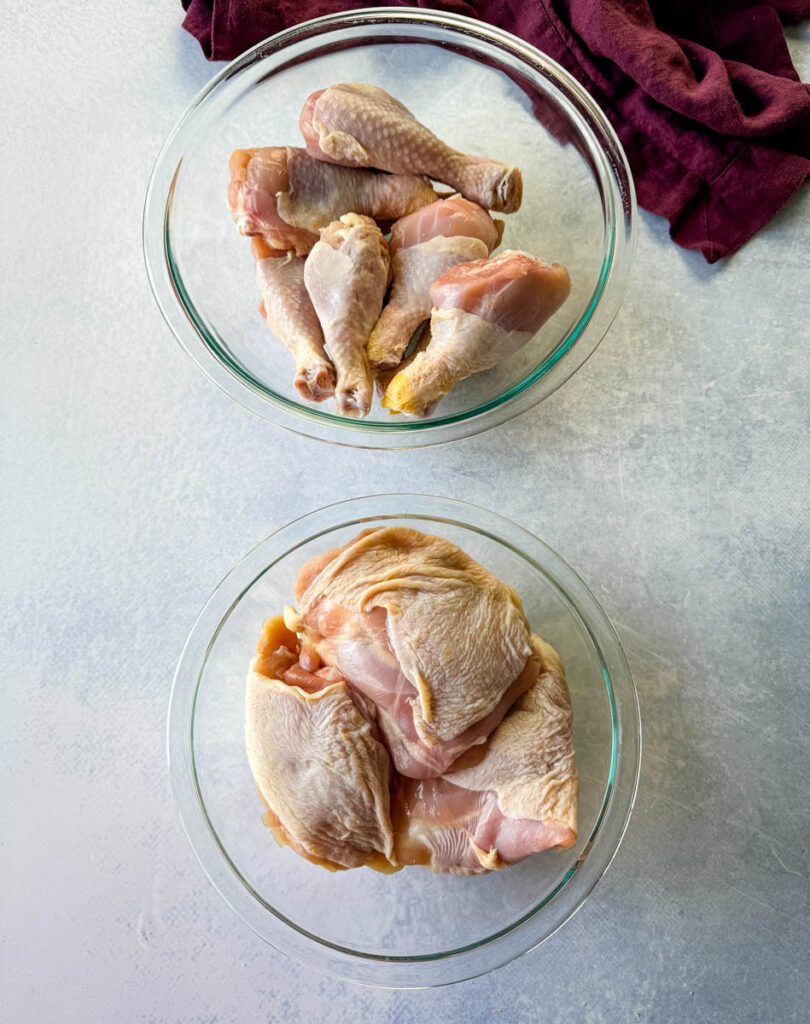
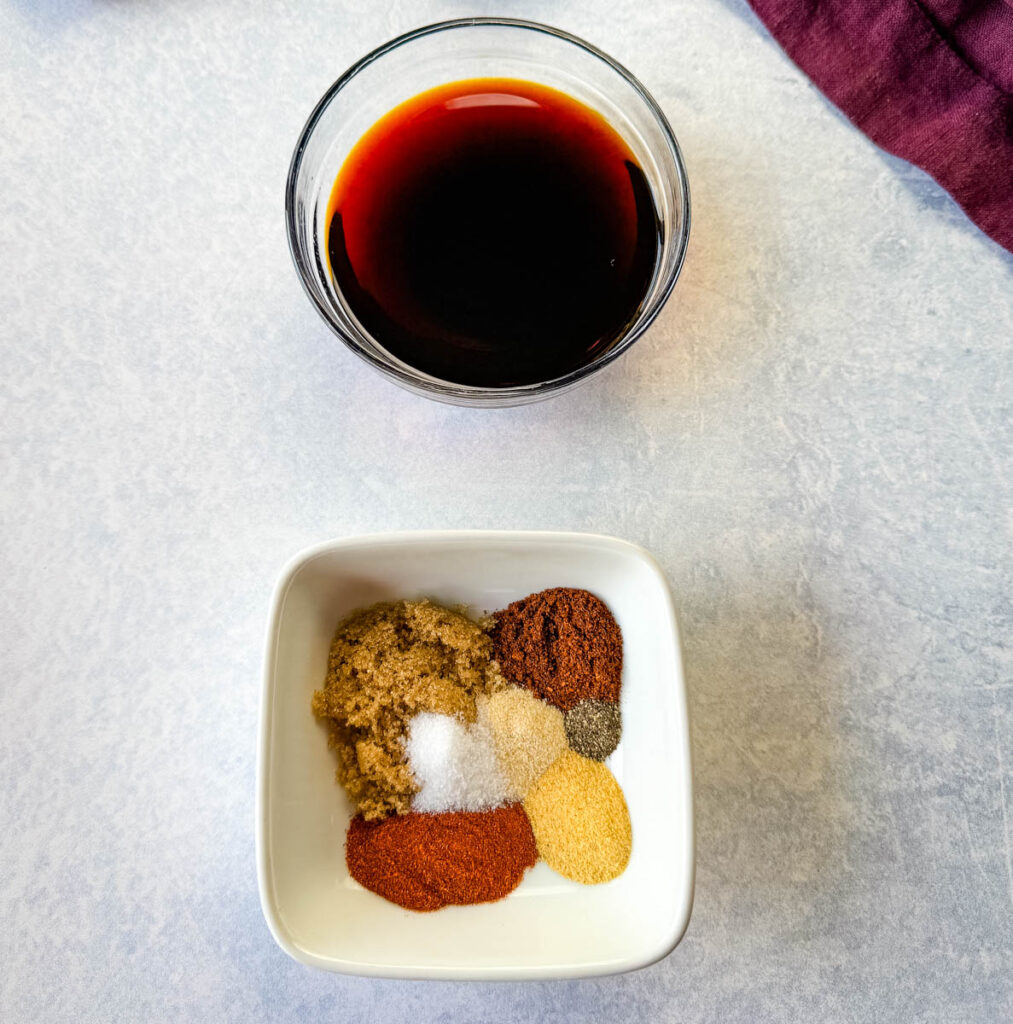
Do You Have to Marinate it?
Marinating is not necessary, but it will certainly enhance the flavor and tenderness of the chicken. If you have the time I recommend it. Marinating allows the chicken to absorb the flavors of the marinade, resulting in a more flavorful and juicy end product. I use my Grilled Chicken Seasoning recipe that includes a marinade.
If you don't want to marinate the meat, omit the soy sauce.
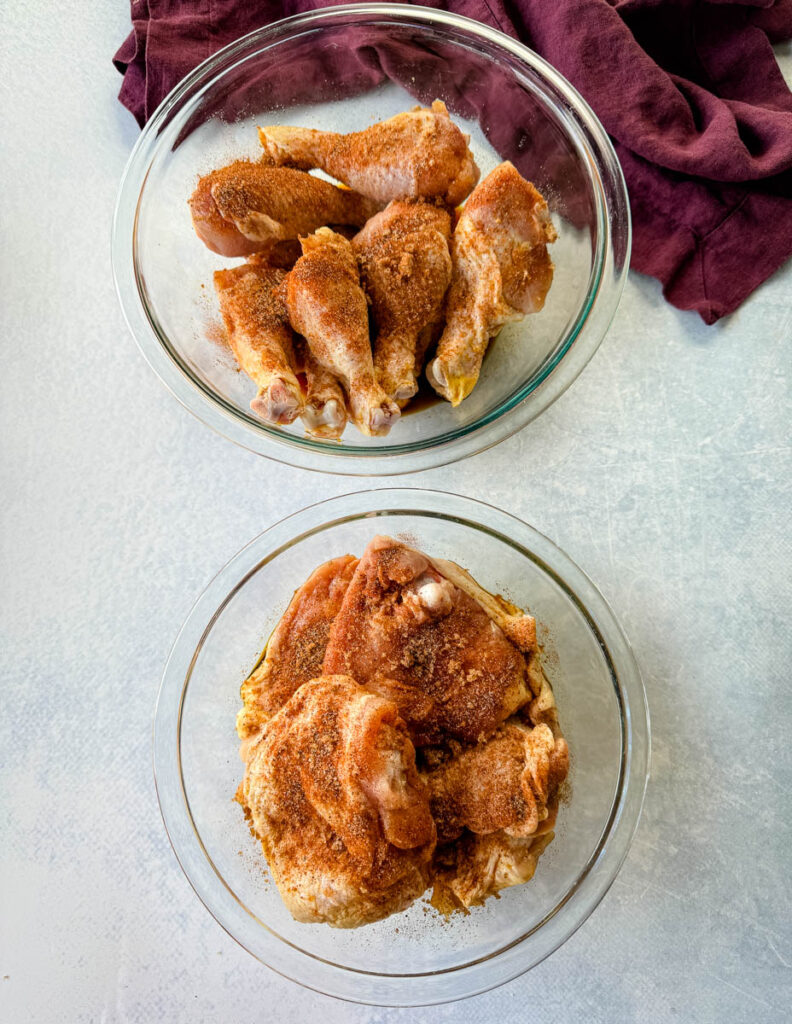
How to Season
I use a combination of smoked paprika, garlic powder, onion powder, chili powder, and brown sugar or sweetener. You can also use a store-bought chicken or poultry rub.
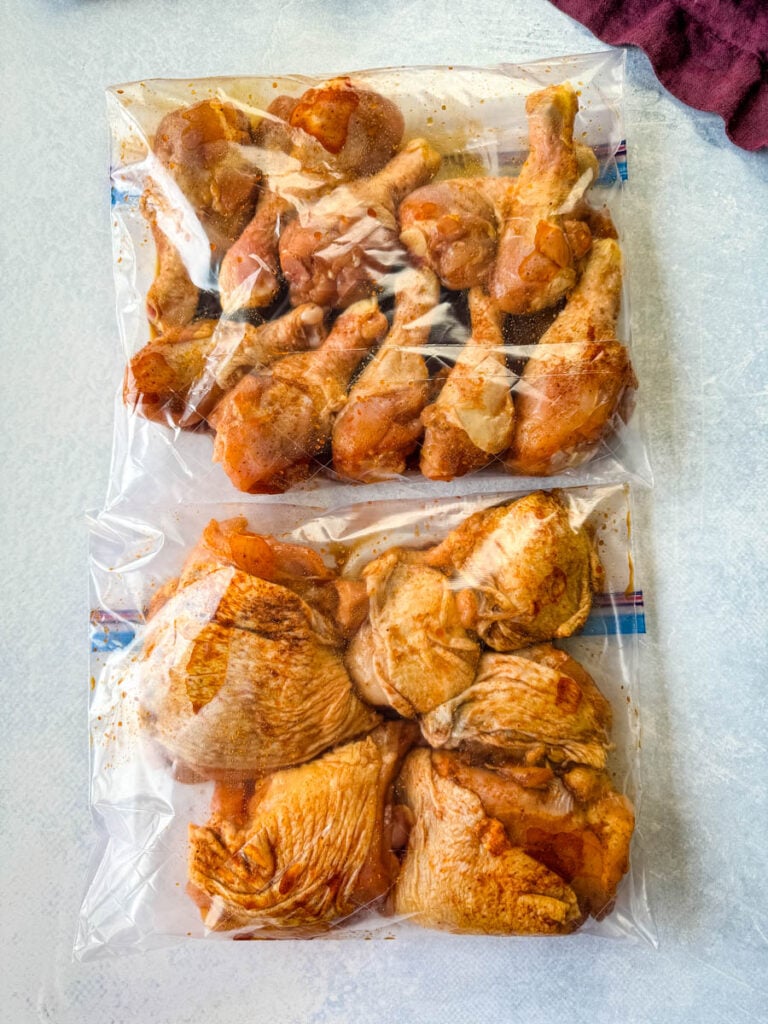
How to Grill BBQ Chicken Drumsticks and Thighs on Gas or Charcoal Grill
Detailed measurements and full instructions can be found in the recipe card at the bottom of this post.
- Season the chicken with the BBQ rub (and marinade if you plan to marinate).
- Place the seasoned chicken on the preheated grill.
- Grill.
- Glaze the chicken with BBQ sauce.
- Remove the chicken from heat and allow the meat to rest.
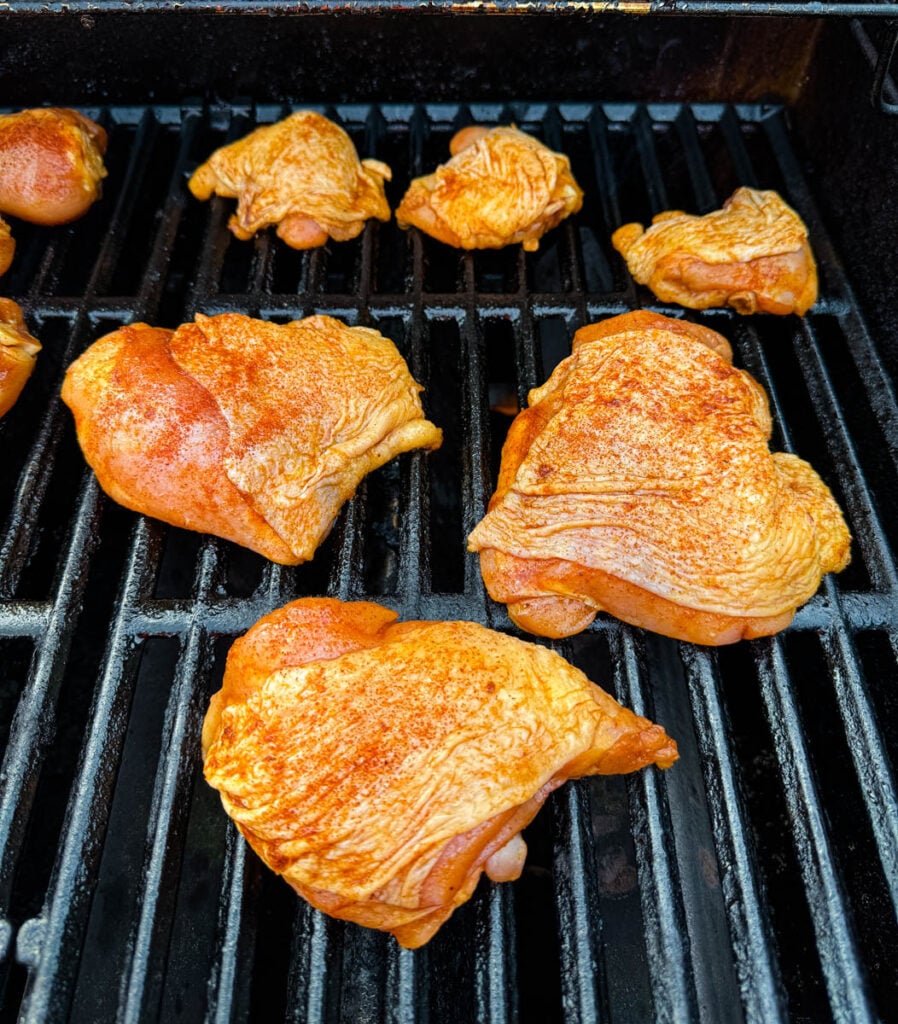
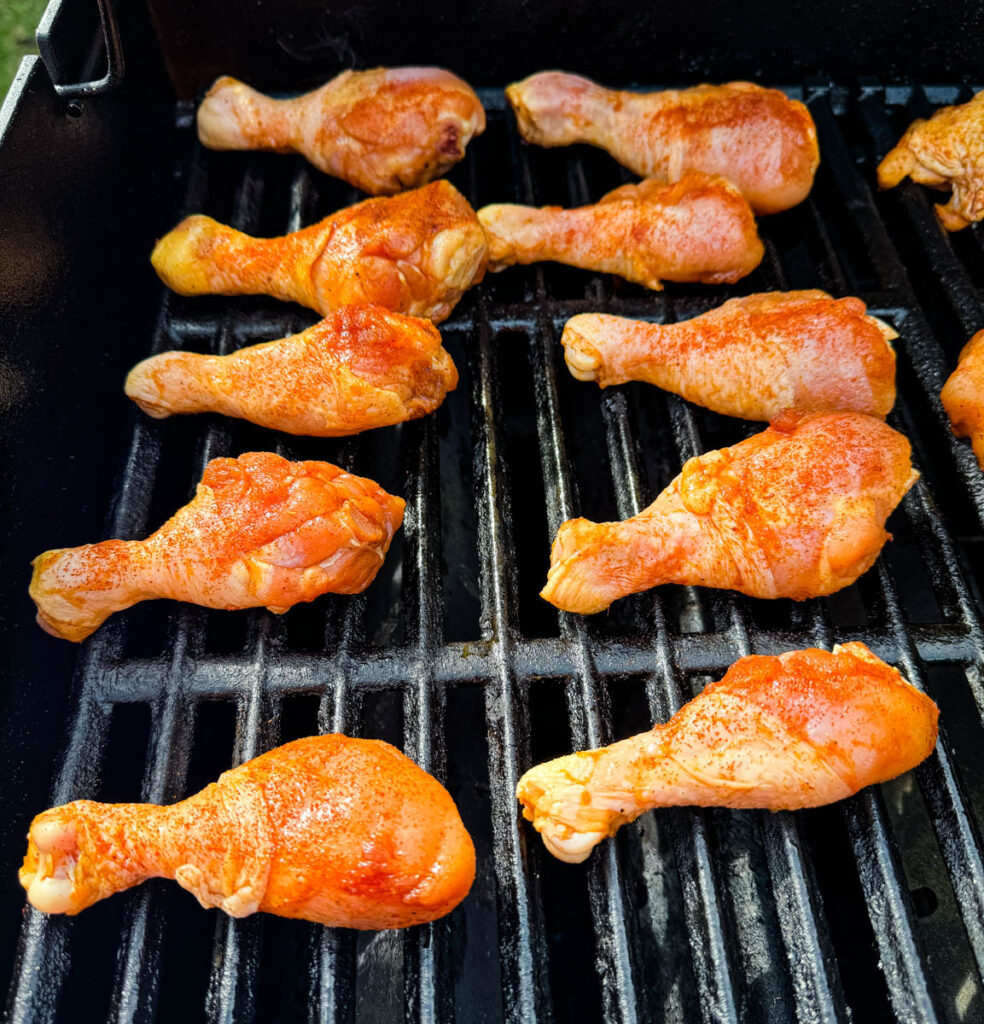
Charcoal Grill vs Gas Grill
You can use either a charcoal grill or gas grill for this recipe. I often use a gas grill. Here are some things to think about:
Gas Grill:
- Flavor: Charcoal grills impart a distinct smoky flavor due to the natural charcoal and wood used for fuel.
- Temperature Control: Charcoal grills can be more challenging to control and maintain a consistent temperature compared to gas grills. It requires careful monitoring of the charcoal and airflow to achieve the desired cooking temperature.
- Prep Time: These grills typically take longer to preheat compared to gas grills, as you need to wait for the charcoal to reach the right temperature before cooking.
- Charcoal Flavor: Some people prefer the flavor of food cooked over charcoal, believing it to be more authentic and flavorful compared to gas-grilled foods.
- Smoke Production: Charcoal grills produce more smoke compared to gas grills, which can enhance the smoky flavor, but may also require extra ventilation to prevent excessive smoke buildup.
Charcoal Grill:
- Convenience: Gas grills offer greater convenience and ease of use compared to charcoal grills. They typically have push-button ignition and allow for precise temperature control with the turn of a knob.
- Temperature Control: Gas grills provide more precise temperature control, allowing you to adjust the heat quickly and easily to maintain the desired cooking temperature.
- Preheating Time: These will heat up faster and require less time to preheat compared to charcoal grills, making them a quicker option for cooking.
- Cleanliness: Gas is generally easier to clean and maintain compared to charcoal grills, as they produce less ash and require less cleanup after cooking.
- Fuel Availability: Nothing hurts more than running out of propane when you're ready to grill! I have been there. Gas grills run on propane or natural gas, which are readily available and easy to store compared to bags of charcoal. This makes gas grills a convenient option, but make sure you have it on-hand.
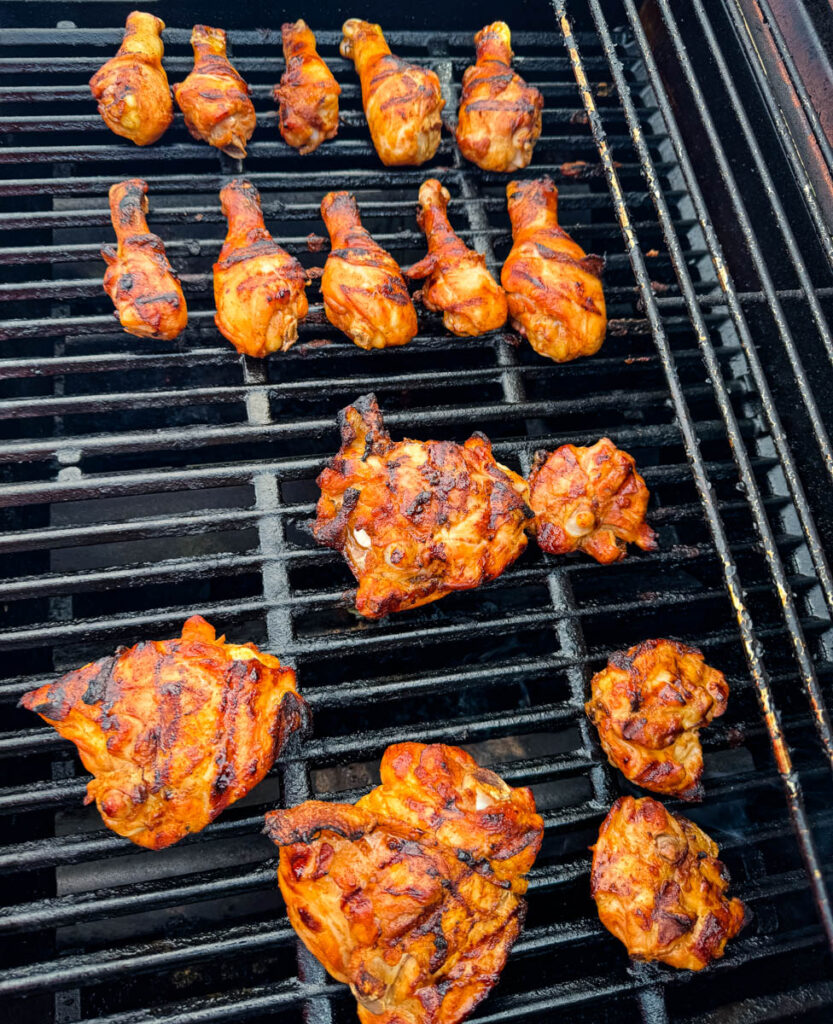
Pro Tips and Frequently Asked Questions
Heat your grill to medium-high heat, around 375-400 degrees. This temperature range allows for thorough cooking without burning the exterior of the chicken.
The best way to determine how long the chicken needs to cook is to use a meat thermometer and test the internal temperature. The cooking time will vary greatly based on the thickness of the meat you're using along with the type and brand of grill you use. You really have to get to know your grill, it's hot spots, and the speed at which it cooks. Here are some guidelines, but alway use a meat thermometer.
The drumsticks will need to cook for about 10-15 minutes on each side.
Bone-in chicken thighs will need to cook for 7-10 minutes on each side.
Boneless chicken thighs will need to cook for 5-7 minutes on each side.
Insert the thermometer into the thickest part of the chicken, avoiding contact with bone. Chicken is safe to eat when it reaches an internal temperature of 165 degrees for all parts, including breast, thighs, wings, and drumsticks.
Cooked chicken should have a golden brown exterior and appear opaque throughout. If you're grilling chicken with bone-in, you can also check for clear juices running from the chicken when pierced with a knife or fork. Any pinkness or translucent areas indicate that the chicken needs more cooking time.
Cooked chicken should feel firm and springy to the touch. If you press down on the chicken with tongs or a fork, it should offer some resistance but still yield slightly. Undercooked chicken will feel soft and mushy, while overcooked chicken will feel dry and tough.
Once the chicken is nearly cooked, brush a generous amount of BBQ sauce onto each piece using a basting brush. Make sure to coat both sides of the chicken evenly for maximum flavor.
After applying the BBQ sauce, continue grilling the chicken for an additional 2-3 minutes on each side. This allows the sauce to caramelize and create a flavorful glaze while finishing cooking the chicken.
Once you remove the chicken from heat, allow it to rest for at least 15 minutes prior to digging in. Allowing the chicken to rest helps the juices redistribute throughout the meat. This helps to keep the meat moist and juicy.
Resting also allows the internal temperature of the meat to even out. The outer layers of the meat will be cooler than the inner layers immediately after cooking. Resting helps to equalize the temperature throughout the meat, resulting in more consistent doneness.
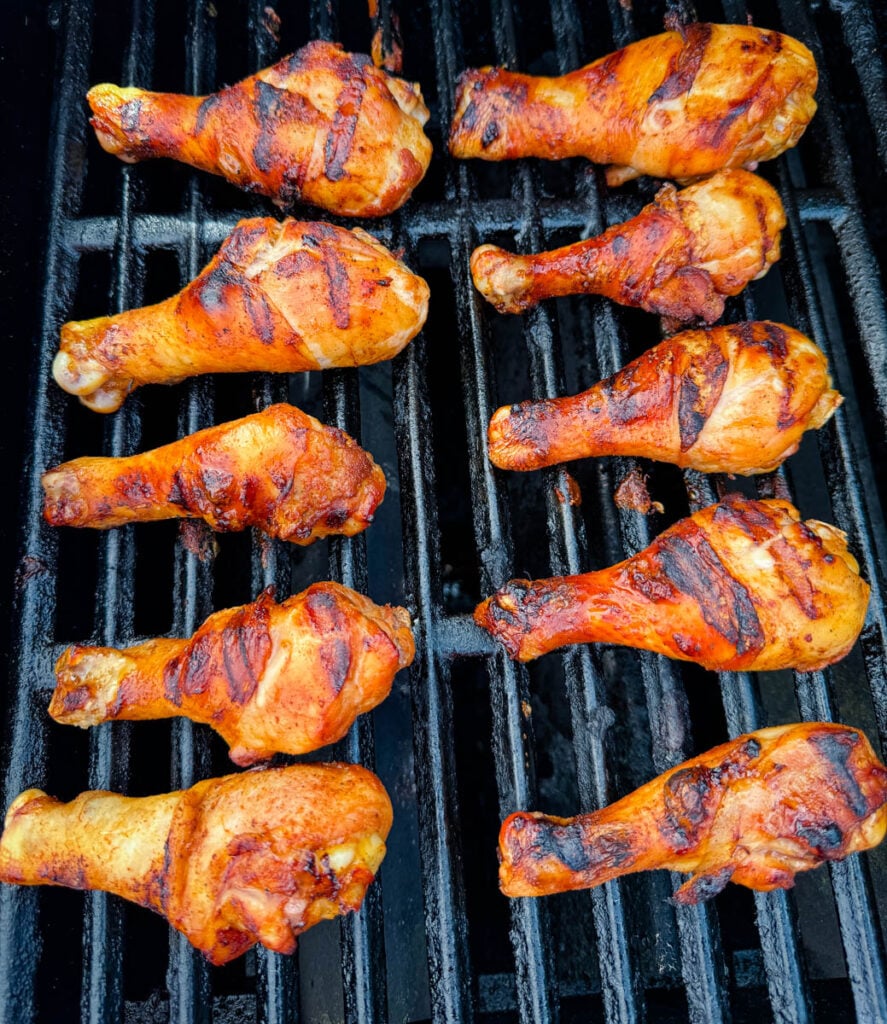

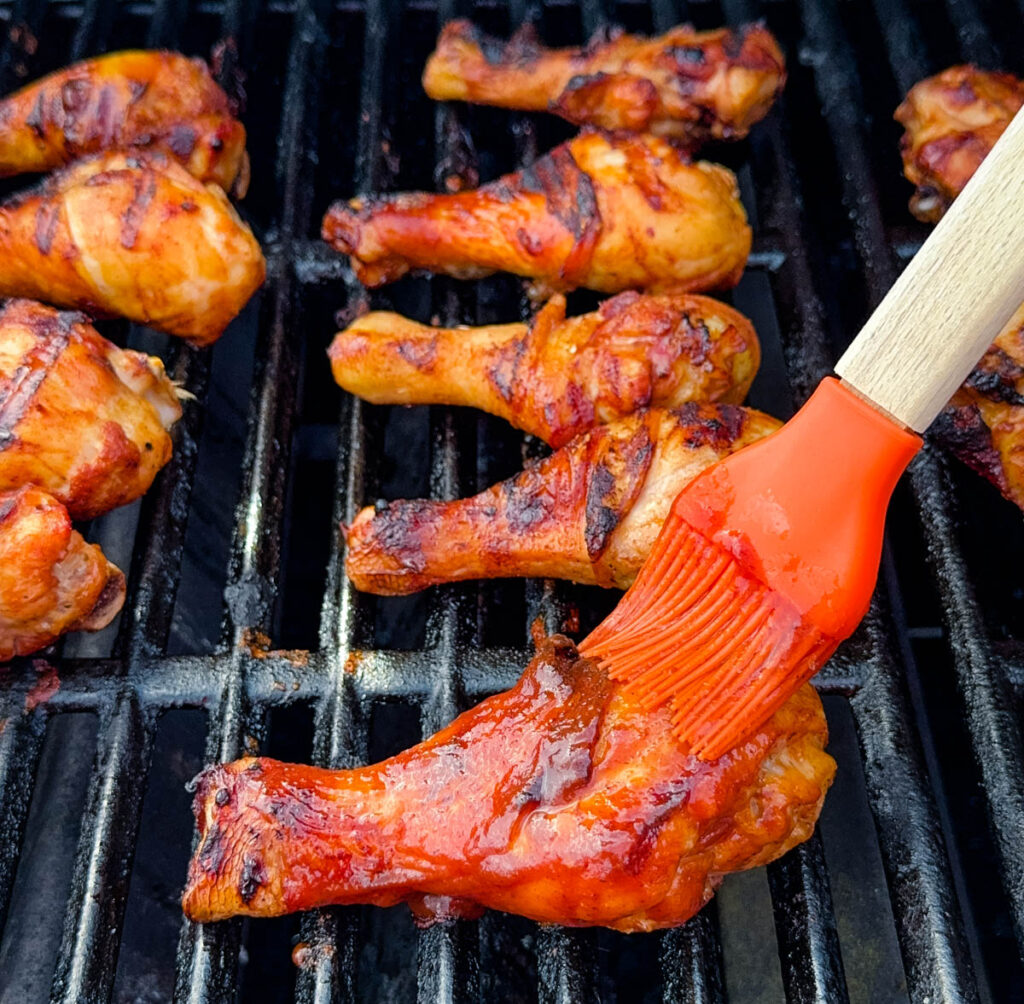
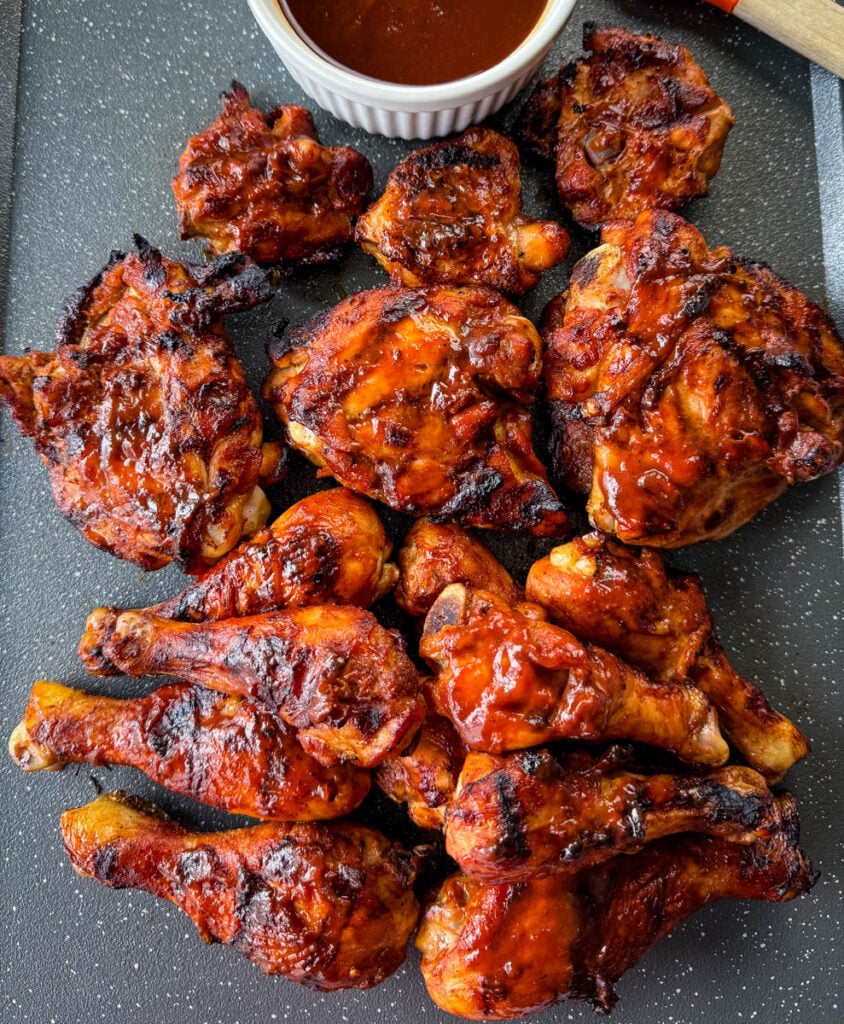
How to Store
You can store leftovers tightly sealed and covered in the fridge for 3-4 days.
How to Reheat
- Oven: Preheat your oven to 325 degrees. Place the chicken on a baking sheet and cover it loosely with aluminum foil to prevent them from drying out. Reheat in the oven until warm.
- Grill: You can reheat the chicken over indirect heat. Preheat the grill to medium heat, then place the chicken on the cooler side of the grill. Cover the grill and cook until warm.
- Stovetop: Place the chicken in a skillet or saucepan with a small amount of chicken broth or water to prevent them from drying out. Cover the skillet and heat over medium-low heat until heated through.
- Microwave: Using the microwave is not the ideal method for reheating as it may dry it out. Place the chicken on a microwave-safe plate. Heat on high for 1-2 minutes, then check the temperature. Continue heating in 30-second intervals until warm.
Freezer Tips
You can freeze leftovers for 2-3 months wrapped and sealed or tightly covered. They can be stored in the freezer for longer periods, it's best to use them within this timeframe to ensure optimal taste and texture.
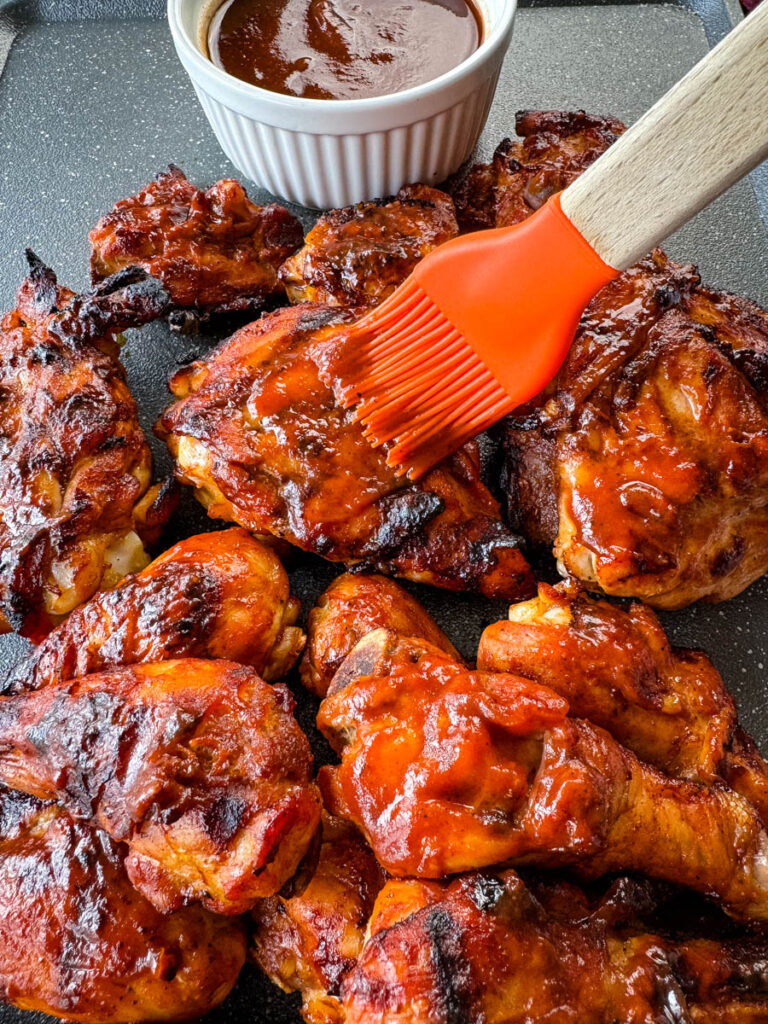
Pair With These Recipes
Potato Salad with Bacon
Smoked Mac and Cheese
Broccoli Salad with Bacon
More Grilled Recipes
Grilled Turkey Legs
How to Grill Ribs on Charcoal or Gas Grill
How to Grill Chicken Wings
Grilled Cod in Foil
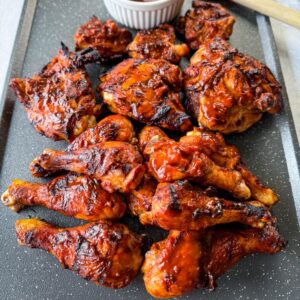
BBQ Chicken Drumsticks and Thighs on Gas or Charcoal Grill
Want to save this recipe for later?
Equipment
Ingredients
- 5-6 pounds chicken thighs and drumsticks I used 3 pounds of bone-in thighs and 3 pounds of drumsticks.
- ½ cup soy sauce
- 1 tablespoon brown sugar or sweetener
- 2 teaspoons chili powder
- 2 teaspoons smoked paprika
- 1 teaspoon onion powder
- 1 teaspoon garlic powder
- salt and pepper to taste
- BBQ sauce Optional
Instructions
- Optional Marinating: Combine the soy sauce and all of the spices and drizzle it over the chicken in a large bowl or plastic bag. Place the chicken in the fridge (covered) for 30 minutes to overnight.If You Don't Plan to Marinate: Sprinkle the spices onto both sides of the chicken and rub the spices into the meat.
- Preheat your grill to medium-high heat, around 375-400 degrees. Make sure the grill grates are clean and lightly oiled to prevent sticking.
- Place the seasoned chicken on the preheated grill. Grill for:Drumsticks will need to cook for about 10-15 minutes on each side.Bone-in chicken thighs will need to cook for 7-10 minutes on each side.Boneless chicken thighs will need to cook for 5-7 minutes on each sidCook time will vary and depend on the thickness of the chicken you are cooking. Use tongs to flip the chicken halfway through the cooking time to ensure even grilling.
- Use a meat thermometer to check the internal temperature. The chicken is safe to eat when it reaches an internal temperature of 165 degrees in the thickest part of the meat.Optional BBQ Sauce: Once the chicken is nearly cooked, brush a generous amount of BBQ sauce onto each piece using a basting brush. Continue to grill for 2-3 minutes. This allows the sauce to caramelize and create a flavorful glaze while finishing cooking the chicken.
- Remove the chicken from heat and allow the meat to rest for at least 15 minutes before serving.
Notes
Nutrition
Nutrition Data
Macros are provided as a courtesy and should not be construed as a guarantee. This information is calculated using MyFitnessPal.com. To obtain the most accurate nutritional information in a given recipe, you should calculate the nutritional information with the actual ingredients used in your recipe, using your preferred nutrition calculator. You are solely responsible for ensuring that any nutritional information provided is accurate, complete, and useful.

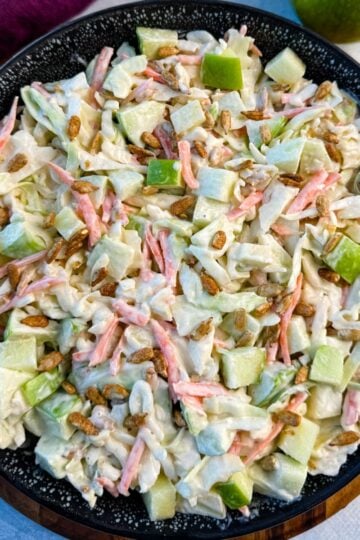
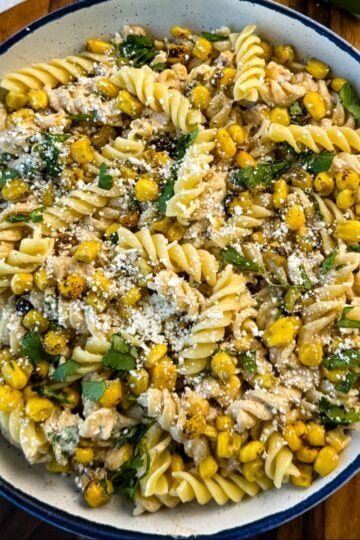
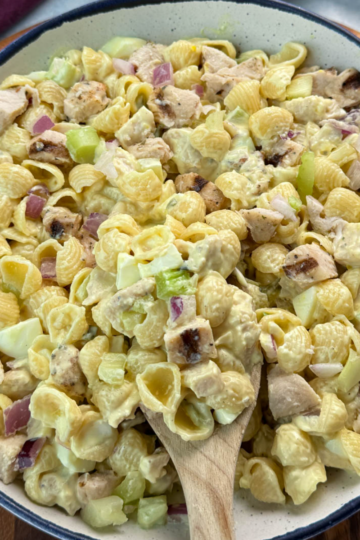

Felicia says
Perfect grilled chicken! I marinated the chicken in the morning and grilled it up for dinner. It was perfectly seasoned and juicy. Definitely making this again!
staysnatched says
So glad to hear you will make it again!